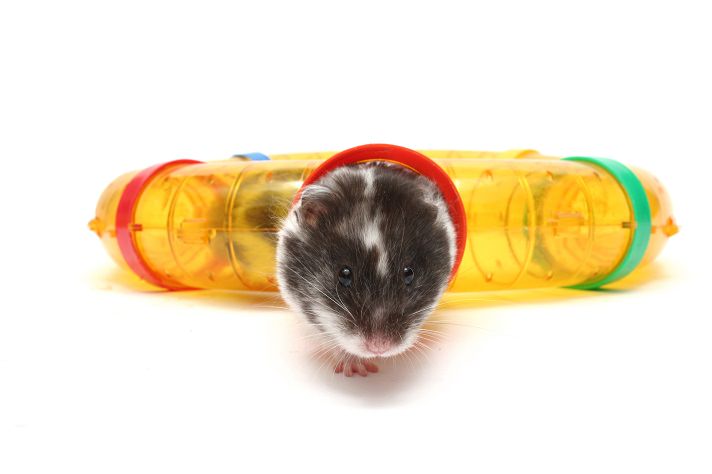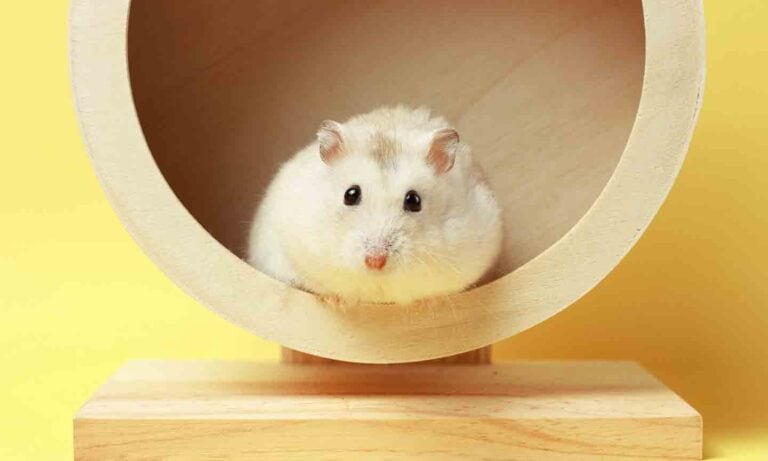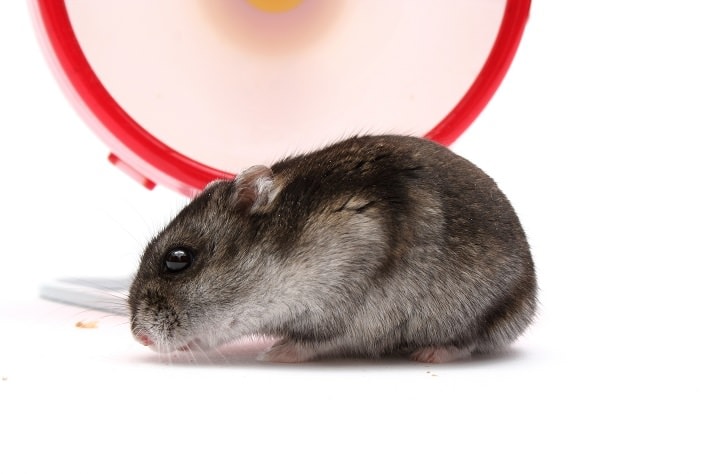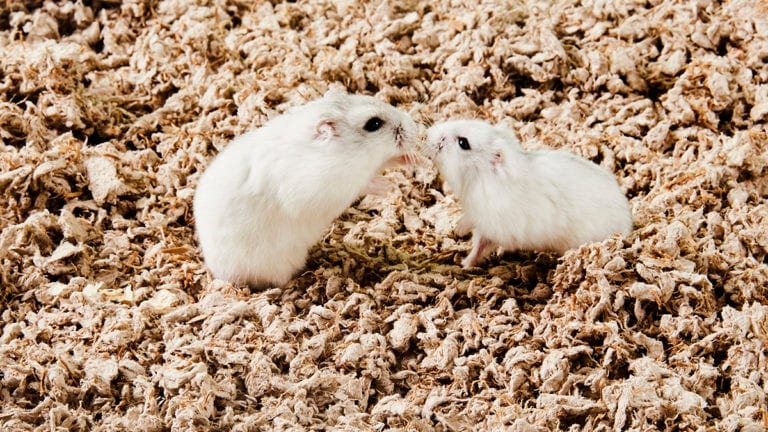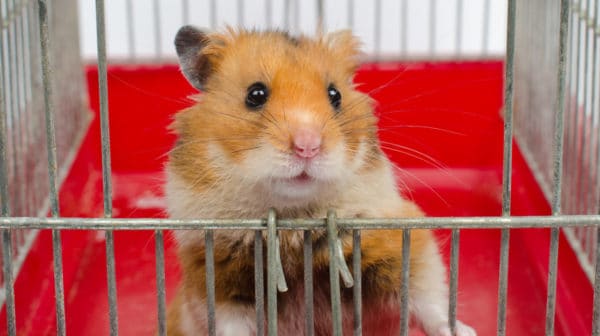The following questions and answers will help you discover if you have what it takes to share your life with a hamster.
1. What Hamster Species Are Kept As Pets?
Five hamster species dominate the pet fancy. The most common is the Syrian hamster (Mesocricetus auratus). As the name implies, this hamster originates from Syria. Its common nicknames include “teddy bear,” “golden” and “black bear” hamster. Syrians typically measure 6 to 7 inches in length and enjoy an average life span of 2 to 2.5 years, although they can live longer. Syrians average about twice the size of other hamster species kept as pets.
The two species of Russian dwarf hamsters include the Campbell’s (Phodopus campbelli) and the Winter White (Phodopus sungorus). The Campbell’s comes in the largest variety of colors. Campbell’s measure 4 to 5 inches in length and generally live 1.5 to 2 years, although they can live longer. Winter White dwarf hamsters measure about 3 to 4 inches in length and live 1.5 to 2 years. They are distinctive because their coat changes color in the winter. When the hours of sunlight decrease, their coat lightens to camouflage them in the snow. They do not breed in their winter coats.
The Chinese hamster (Cricetulus griseus) is smaller than the Syrian hamster and is sometimes lumped in with the dwarf hamsters. Technically, though, it is part of the family of mouse-like hamsters, but its care is similar to the dwarf hamsters. Chinese hamsters are less popular than the Russian hamster species, probably partly due to their mouse-like appearance. They are generally 4 to 5 inches long, live 2 to 3 years and originated in China and Mongolia.
The Roborovski dwarf hamsters (Phodopus roborovskii) are the smallest of the dwarf species at 1.5 to 2 inches in length. They are also the only dwarf species without the distinctive dorsal stripe in their wild color. On average, they live the longest of any pet hamster species — an average of 3 to 3.5 years. They are difficult to handle, but enjoy interacting with people in their cage environment. Their quickness makes them a more difficult pet, and they are not recommended for children.
2. What Key Differences Exist Between The Species?
The biggest care difference is that Syrians are solitary and must always be housed alone. The dwarf hamsters and the Chinese hamster are social hamsters and should be kept in pairs or small groups.
The black bear hamsters are identical to other hamsters with one single exception: color. No other difference exists, genetically or in terms of care. The black gene mutation is only known to occur in the Syrians and Campbell’s.
Syrians may be seen living in groups at pet stores, but as they reach the age of 8 to 10 weeks, they must be separated and housed alone. Almost all Syrian adults fight. The fights are quite sudden, often fatal and usually occur at night. Syrian hamsters forced to live together rarely thrive or reach their potential as a happy and healthy pet.
All dwarf species and the Chinese hamster do best in pairs, with groups being second best and solitary being the worst. Same sex or mixed sex doesn’t usually matter, depending on whether you wish to breed them or not. Occasionally, a dwarf pair will fight and have to be separated.
Classic signs of problems include bloodshed, sudden weight loss, and/or frequent chasing around the cage. Once problems occur, they must be separated and, usually, live alone for the rest of their lives.
Cages and toys should also be geared to the appropriate species. Many wheels are too small for Syrians and force them to arch their backs to run. Tubes are often too large for dwarf hamsters, leading to falls. Make sure you assess each cage for the species you decide on and replace any parts not suitable for your chosen pet.
3. Which Species Is Best For Me?
Choosing a species is a personal decision. The smaller species are active and tend to constantly wander and explore.
Syrians tend to be slower in their movements and easier for children to handle. Thus, Syrians are the recommended species for children less than 10 years of age. No hamster species is recommended for children less than 5 years of age. (Should this be done, a child younger than 5 must have strict parental guidance).
Hamsters generally enjoy human interaction. They are curious and enjoy exploring their surroundings. All hamster species are nocturnal, with morning or evening being the best time for interaction.
4. Do Veterinarians Treat Hamsters?
Not all veterinarians treat hamsters. Those who do are typically called “exotics” vets. Locate a vet in your area who treats hamsters before you buy your pet. When hamsters get sick, they deteriorate rapidly. They will need immediate treatment, and searching for a suitable vet wastes precious time.
5. What Are Some Common Health Problems?
Although, generally healthy animals, hamsters do occasionally get sick. Once a hamster shows signs of illness, isolate him from other animals and seek immediate medical attention. Time is precious, because hamsters succumb to illness rapidly.
Health problems common to multiple hamster species include fur loss and sensitivity to heat. Fur loss can be caused by old age, improper diet, mites, allergies to food, bedding, etc. To avoid problems with heat, keep hamsters out of direct sunlight at all times. Other conditions that can occur include abscesses, tumors, heart attacks and strokes. Wet tail, which is a bacterial infection that often develops near weaning time and causes diarrhea, occurs in Syrians. Campbell’s seem susceptible to diabetes. For more about hamster health, check out our Hamster Health Center here.
6. What Is The Ideal Hamster Habitat?
Aquariums often serve as hamster habitats. The 10-gallon size is the absolute minimum to use. Larger is better, because hamsters thrive in larger living quarters. Readily available and relatively inexpensive, aquariums hold in shavings well and are easy to clean. But, they tend to be heavy — making it impossible for a small child to clean alone. If you get an aquarium, get one with a secure, locking, ventilated top.
Wire cages are popular hamster habitats. However, hamsters can climb these, so ensure that they cannot injure themselves if they fall. Ground floor space is much more important than multiple levels. Keep wire cages out of drafty areas. Shavings will spill out of a wire cage, increasing clean up.
Wire cage bars need to be close together to prevent escapes — especially by dwarf hamsters. Replace the exercise wheels in these cages if they are wire wheels because wire allows a hamster’s feet to fall through and get injured. Check the doors to see if they are too small to allow removal of your hamster by hand.
Tube cages are popular. They allow for easy expansion and can be pleasing to the human eye. However, they can take longer to clean. Escape-proof them carefully.
Plastic cages made from clear plastic storage tubs have become popular in recent years. They come in virtually any size. They’re also light and easy to clean. Snap-locking lids make them reasonably secure. You’ll need to modify the lids for proper ventilation by cutting a large hole in the center of the lid and replacing it with hardware cloth.
No matter what habitat you choose, keep it clean. Clean your hamster’s cage once a week with water or mild detergent, followed by a thorough rinsing.
7. What Should I Feed My Hamster?
Diet is important to maintain good health. Hamsters do not typically overeat. They hoard any surplus food for later consumption. However, they can get fat if their diet is poor. Too many sunflower seeds and/or peanuts are probably the leading cause of obesity in hamsters. The simple solution is to remove all sunflower seeds and peanuts from any mix that you buy. Ration these and feed them as treats.
Purchase a quality grain mix or lab pellet, and feed your hamster daily. Lab pellets are a larger pressed pellet. Examine the ingredients of any food you purchase and carefully check the bag to ensure freshness and a lack of bugs. (Place the bag in the freezer for 24 hours before using, which should kill any bugs.) Always make sure that your hamster has some extra food, but not enough that he can only eat his favorite bits.
8. What Are Some Favorite Hamster Treats?
The best treats are healthy treats fed in moderation. If your hamster mix comes with sunflower seeds or peanuts, remove them before feeding the mix and give as treats when you play with your hamster. Small chunks of fresh fruits or vegetables are also appreciated.
To avoid stomach upset, introduce fruits and vegetables in moderation if your hamster is not used to them. Apples, broccoli, carrots, cucumbers and strawberries are hamster favorites. Avoid citrus fruits, tomatoes, onions and iceberg lettuce, which can all cause distress. Remove any uneaten portions after a few hours, because hamsters tend to store the extra with their dry food, causing spoilage.
Other healthy treats include small quantities of tofu, scrambled egg (without spices or butter), boiled chicken, unflavored yogurt and small pieces of bread or cooked pasta. Hamsters enjoy an occasional small dog biscuit, which also serves to keep their teeth trimmed.
9. What Toys Should I Get My Hamster?
An exercise wheel, first and foremost. Wheels allow hamsters to run and exercise when they wish, which is usually during the night. Avoid runged, wire wheels because these may cause leg injuries.
Hamster balls are probably the next most popular toy. These balls allow the hamster to safely roam and explore in the house — as long as the owner blocks off stairs and other potential dangers. Many other commercially available toys can delight your hamster. Look for toys that are easily cleaned.
For quick fun, offer your hamster a toilet paper roll with just the last few sheets of plain, unscented toilet paper left on it. Boxes with holes cut in various places are also appreciated and can be replaced with a new variation at each cage cleaning. Be creative and look for suitable toys to rotate in and out of your hamster’s cage. Your pet will appreciate some variety.
10. What Should I Look For When Buying A Hamster?
Look for a hamster that is alert, healthy and curious about his surroundings. Observe him in his home. Check that the eyes are wide and responsive, with no discharge. Look for signs of fighting, evidenced by torn ears and sores or scabs around the nose and tail. Run your fingers across his back, feeling down to the skin for sores. Part the fur to examine the color and texture. Look for smooth, pink or pigmented skin. Hamsters with red or scaly skin may need medical attention.
Always check a hamster’s underside, even if he squirms. There should be fur on the belly with no bald spots, but particularly check for diarrhea. Diarrhea can occur in all species but is particularly troublesome as a symptom of wet tail in the Syrians. Do not purchase any hamster from a location where even one hamster has diarrhea unless you are prepared for a trip to the vet on very short notice.
The ideal age to buy hamsters is when they are 5 to 10 weeks of age. Younger animals have often been stressed and are more susceptible to illness. Older hamsters may actually be gentler if handled regularly, but age is difficult to determine.
11. I Have A New Hamster. What Now?
Hamsters usually need some time to adjust to their new surroundings. Minimal handling in the first few days after purchase is a must — and then only by the main caregiver. Hamsters use their noses to assess their surroundings. Thoroughly wash your hands with unscented soap before handling your hamster. Initially, handling should always take place close to the ground — preferably on carpet. Young and frightened hamsters often jump.
12. Should I Breed My Hamster?
In general, no. Much research needs to be done before breeding any animal; hamsters are no exception. Finding a healthy line worthy of breeding is often difficult. Hamsters are prolific breeders, and finding homes can be a challenge for the first litter, let alone the many that usually follow in the case of Dwarf hamsters. Complications are not uncommon, so a strong relationship with a veterinarian is essential.
By: Linda Price
Share:
